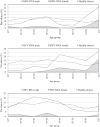Prevalence and trends of markers of hepatitis B virus, hepatitis C virus and human Immunodeficiency virus in Argentine blood donors
- PMID: 24755089
- PMCID: PMC4018657
- DOI: 10.1186/1471-2334-14-218
Prevalence and trends of markers of hepatitis B virus, hepatitis C virus and human Immunodeficiency virus in Argentine blood donors
Abstract
Background: Transfusion-transmitted infections are a major problem associated with blood transfusion. The aim of this study was to determine prevalence and trends of HBV, HCV and HIV in blood donors in Argentina.
Methods: A retrospective study was carried out in blood donors of 27 transfusion centers covering the whole country over a period of eight years (2004-2011). Serologic screening assays for HBsAg, anti-HBc, anti-HCV, and anti-HIV were performed in all centers and nucleic acid amplification testing (NAT) was performed in 2 out of the 27 centers.
Results: The 2,595,852 samples tested nationwide from 2004 to 2011 showed that the prevalence of HBsAg decreased from 0.336% to 0.198% (p < 0.0001), that of anti-HBc from 2.391% to 2.007% (p < 0.0001), that of anti-HCV from 0.721% to 0.460%, (p < 0.0001) and that of anti-HIV from 0.208% to 0.200 (p = 0.075). The prevalence of HBV, HCV and HIV was unevenly distributed among the different regions of the country. Two out of 74,838 screening- negative samples were positive in NAT assays (1 HIV-RNA and 1 HCV-RNA); moreover, HBV-DNA, HCV-RNA and HIV-RNA were detected in 60.29, 24.54 and 66.67% of screening-positive samples of the corresponding assays. As regards donors age, positive HBV-DNA and HCV-RNA donors were significantly older than healthy donors (46.6, 50.5 and 39.5 y respectively, p < 0.001).
Conclusions: Argentina has a low prevalence of HBsAg, anti-HCV and anti-HIV in blood donors, with a decreasing trend for HBsAg, anti-HBc and anti-HCV but not for anti-HIV over the last 8 years. The uneven distribution of transfusion-transmitted infections prevalence among the different regions of the country highlights the need to implement regional awareness campaigns and prevention. The discrepancy between samples testing positive for screening assays and negative for NAT assays highlights the problem of blood donors who test repeatedly reactive in screening assays but are not confirmed as positive upon further testing. The uneven distribution of age between healthy donors and NAT-positive donors could be related to changes in risks of these pathogens in the general population and might be attributed to a longer exposure to transmission risk factors in elderly people.
Figures



Similar articles
-
Significant increase in HBV, HCV, HIV and syphilis infections among blood donors in West Bengal, Eastern India 2004-2005: exploratory screening reveals high frequency of occult HBV infection.World J Gastroenterol. 2007 Jul 21;13(27):3730-3. doi: 10.3748/wjg.v13.i27.3730. World J Gastroenterol. 2007. PMID: 17659734 Free PMC article.
-
Seroprevalence of hepatitis B, hepatitis C, human immunodeficiency virus, Treponema pallidum, and co-infections among blood donors in Kyrgyzstan: a retrospective analysis (2013-2015).Infect Dis Poverty. 2017 Feb 21;6(1):45. doi: 10.1186/s40249-017-0255-9. Infect Dis Poverty. 2017. PMID: 28222792 Free PMC article.
-
The characteristics of hepatitis B surface antigen (HBsAg)-negative hepatitis B virus (HBV) infection in Chinese blood donors: a follow-up study of donors tested negative for HBsAg and reactive for simultaneous nucleic acid testing of HBV, hepatitis C virus, and human immunodeficiency virus.Transfusion. 2017 Mar;57(3pt2):832-840. doi: 10.1111/trf.14014. Epub 2017 Feb 5. Transfusion. 2017. PMID: 28164313
-
Should HBV DNA NAT replace HBsAg and/or anti-HBc screening of blood donors?Transfus Clin Biol. 2004 Feb;11(1):26-32. doi: 10.1016/j.tracli.2003.12.003. Transfus Clin Biol. 2004. PMID: 14980546 Review.
-
New strategies for blood donor screening for hepatitis B virus: nucleic acid testing versus immunoassay methods.Mol Diagn Ther. 2006;10(2):77-91. doi: 10.1007/BF03256447. Mol Diagn Ther. 2006. PMID: 16669606 Review.
Cited by
-
Prevalence of overt and occult hepatitis B virus infections among 135 haemodialysis patients attending a haemodialysis centre at Al-Nasiriyah city, Iraq.Iran J Microbiol. 2020 Oct;12(5):475-482. doi: 10.18502/ijm.v12i5.4610. Iran J Microbiol. 2020. PMID: 33604004 Free PMC article.
-
Hepatitis C virus pharmacogenomics in Latin American populations: implications in the era of direct-acting antivirals.Pharmgenomics Pers Med. 2017 Mar 28;10:79-91. doi: 10.2147/PGPM.S125452. eCollection 2017. Pharmgenomics Pers Med. 2017. PMID: 28405170 Free PMC article. Review.
-
The Trends of Viral Hepatitis B and C and HIV Infections in Donated Bloods in Iran Between 2003 and 2017.J Blood Med. 2019 Dec 18;10:435-441. doi: 10.2147/JBM.S229327. eCollection 2019. J Blood Med. 2019. PMID: 31908558 Free PMC article.
-
Prevalence, incidence and residual risk of transfusion-transmitted HBV infection before and after the implementation of HBV-NAT in northern Brazil.PLoS One. 2018 Dec 19;13(12):e0208414. doi: 10.1371/journal.pone.0208414. eCollection 2018. PLoS One. 2018. PMID: 30566494 Free PMC article.
-
Prevalence of hepatitis C virus infection according to the year of birth: identification of risk groups.Eur J Clin Microbiol Infect Dis. 2018 Feb;37(2):247-254. doi: 10.1007/s10096-017-3123-4. Epub 2017 Oct 27. Eur J Clin Microbiol Infect Dis. 2018. PMID: 29076048
References
Publication types
MeSH terms
Substances
LinkOut - more resources
Full Text Sources
Other Literature Sources
Medical
Research Materials

